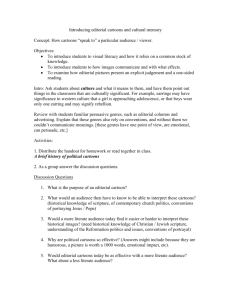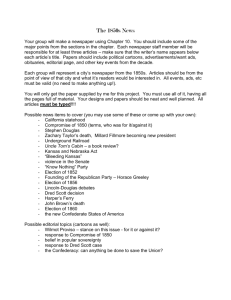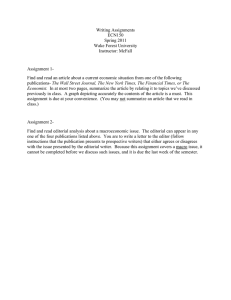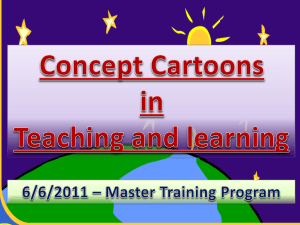1 Media plays vital roles in ... mentioned that media carries ...
advertisement
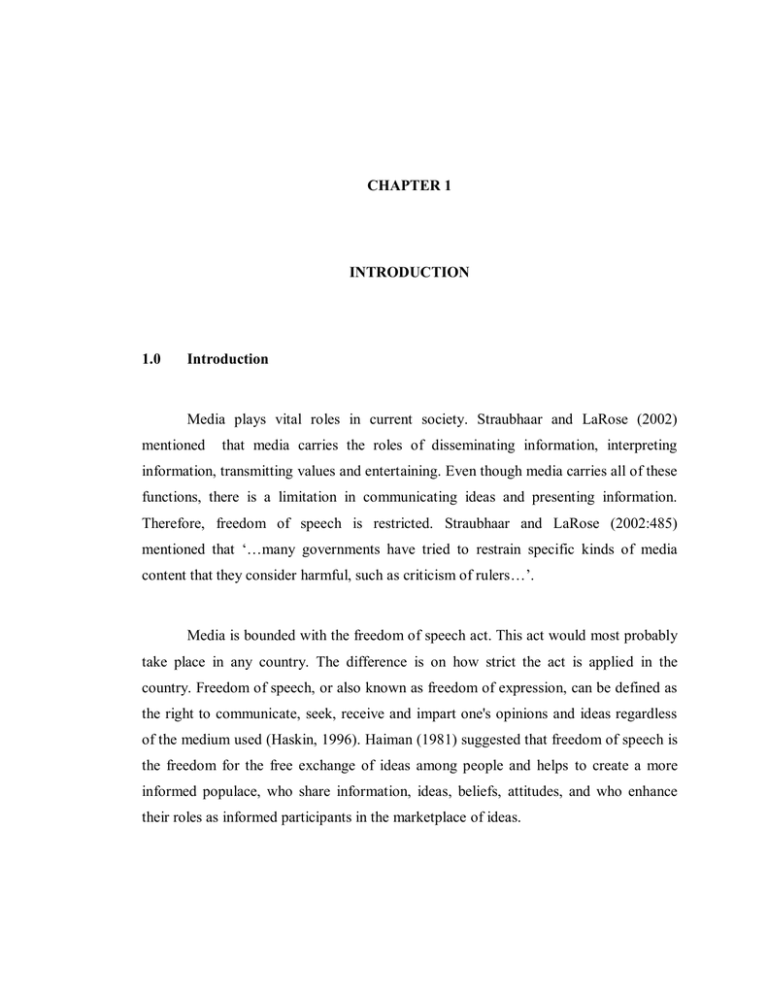
1 CHAPTER 1 INTRODUCTION 1.0 Introduction Media plays vital roles in current society. Straubhaar and LaRose (2002) mentioned that media carries the roles of disseminating information, interpreting information, transmitting values and entertaining. Even though media carries all of these functions, there is a limitation in communicating ideas and presenting information. Therefore, freedom of speech is restricted. Straubhaar and LaRose (2002:485) mentioned that ‘…many governments have tried to restrain specific kinds of media content that they consider harmful, such as criticism of rulers…’. Media is bounded with the freedom of speech act. This act would most probably take place in any country. The difference is on how strict the act is applied in the country. Freedom of speech, or also known as freedom of expression, can be defined as the right to communicate, seek, receive and impart one's opinions and ideas regardless of the medium used (Haskin, 1996). Haiman (1981) suggested that freedom of speech is the freedom for the free exchange of ideas among people and helps to create a more informed populace, who share information, ideas, beliefs, attitudes, and who enhance their roles as informed participants in the marketplace of ideas. 2 Crossing the limit of the freedom of speech may result in undesirable actions to the involved person. There are cases in which people were jailed due to crossing the boundaries of freedom of speech (Collier, 2011). Therefore, it can be said that stating one’s idea freely through the media may bring negative implications when the boundaries of the freedom of speech are crossed. Nevertheless, freedom of speech may bring benefit to the people because when people are well informed with the truth, they are able to make best choices for themselves and others (Haiman, 1981). Consequently, this results for a need to conduct studies on issues related to media, which is one of the mediums for the freedom of speech. Therefore, this study focused on one type of media, which is editorial cartoons. Editorial cartoons can be found in the newspaper. Editorial cartoon is connected to freedom of speech since editorial cartoon is a way for the cartoonist to express their views on an issue. Issues catered in the editorial cartoons are commonly related to the current issues of the society such as social issues and political issues (Mahamood, 2004). The use of editorial cartoons is very wide. Markow (1972) mentioned that several hundred millions people around the world read cartoons everyday and this is made possible by the distribution of cartoons via newspapers. However, the usage and the acceptance of editorial cartoons are different from one country to another. In Europe, the citizens and the rulers are more open (Tunç, 2002). Besides, Tunç (2002:49) also stated that within ‘western bourgeois democracies, political cartoonist has the right to participate in the political discourse’. On the other hand, the Turkish practices a more closed policy (Tunç, 2002). Strict rules were implemented in the aspect of drawing and publishing issues related to political issues. For example, Abdülhamid II, the 34 th sultan of Turkey had abolished press freedom as he became aware of the power of the media (Tunç, 2002). While in Japan, the study conducted by Feldman (1995) on Japanese cartoons showed that the editorial cartoon is an important form of political communication. 3 Media, including editorial cartoons, are linked with the freedom of speech. Crossing the boundaries of freedom of speech may result in undesirable actions. An interview conducted between Collier (2011) and five cartoonists (Tony Namate from Zimbabwe; Alfredo Pong from Cuba; Pedro León Zapata fromVenezuela; Aw Pi Kyeh (APK)from Burma; Jonathan Shapiro from South Africa) reveals that they have gone through a lot of challenges that are related to the boundaries of freedom of speech in the process of publishing their cartoons. Similar situation also happened in Malaysia. In 2010, Zulkifli Anwar Ulhaque, or commonly known as Zunar, was arrested several hours before the expected launch of his book entitled Cartoon-O-Phobia and was released a day after. Consequently, he had filed a civil suit and in 2012 Zunar partially won the case. From here, it can be said that presenting one’s ideas freely through editorial cartoons may be a risky task. However, one cartoonist in Malaysia managed to comment and portray one of the Malaysian political figures, Tun Dr Mahathir, and the cartoons are well accepted by the society and politicians (Zaini Ujang, 2009). The cartoonist is Lat (Zaini Ujang, 2009). This research focused on how Lat had represented Tun Dr Mahathir in his editorial cartoons through visual and linguistic elements. 1.1 Background of the Study Lat or his real name Mohammed bin Nor Khalid has become an editorial cartoonist since the year of 1975. As an editorial cartoonist, Lat tried to be more open and critical in presenting his ideas and views on the social issues as well as the political issues (Lent, 2003; Muliyadi Mahamood, 2004). Lent (2003) mentioned that Lat’s first attempt in portraying Malaysia’s second Prime Minister, Tun Abdul Razak, was disapproved by Tan Sri Lee Siew Yee, who was the editor-in-chief of the New Straits Times at that time. The next attempt, in which he drew Tun Hussein Onn’s caricature on a back of a camel and saying that he needs to reduce his speed as he reaches Malaysia 4 from Saudi Arabia because a new salary scale would be applied once he reaches Malaysia (Figure 1.1), was allowed by Tan Sri Lee Siew Yee (Muliyadi Mahamood, 2004). In Figure 1.1, the caricature of Tun Hussein Onn saying “Oi! Slow down…We’re going too fast!” whilst holding a newspaper with a headline “New Salary Scales to be Implemented Soon after Datuk Hussein Returns”. His style of editorial cartoons was then became more accepted by the citizens as well as the political figures (Zaini Ujang, 2009). Figure 1.1 : Editorial Cartoons by Lat (News Straits Times, 1975) Muliyadi Mahamood (2004) described Lat’s style of drawing as subtle, indirect, and symbolic. Muliyadi Mahamood (2003:72) also mentioned that when Lat produced critical editorial cartoons, he would describe the situation of the political figures in an "unusual, abnormal or unexpected" way in contrast to their status or personalities. The difference between their status and the unexpected situations results in humorous cartoons. In addition, Muliyadi Mahamood (2004) stated that Lat was able to push the boundaries or the limitations, in which the local cartoonists back then had not crossed. 5 Lat confessed that there are some of his works that remain unprinted as the editors did not agree to publish the cartoons without any changes and Lat added that "Okay, maybe I've pushed the line a little bit, but I've never got into trouble and, frankly, only a handful of my cartoons were ever spiked” (Jayasankaran, 1999: 36). During the fourth Malaysian Prime Minister, Tun Dr Mahathir Mohammad’s ruling, Lat had produced a lot of editorial cartoons about Tun Dr Mahathir. Tun Dr Mahathir and Lat are not related, however Tun Dr Mahathir is one of his favourite subjects in his cartoons (Abdul Kadir Jasin, 2004). Muliyadi Mahamood (2003) stated that the long career line of the political figure gives more than 20 years worth of materials to the cartoonist and it makes him a frequent target to the cartoonist. Abdul Kadir Jasin (2004: 14) also mentioned that Tun Dr Mahathir is Lat’s “most famous and favourite subject”. Tun Dr Mahathir bin Mohamad is the fourth Malaysian Prime Minister. Tun Dr Mahathir had become the Prime Minister on 16th July 1981 until 31st October 2003. He held the position for 22 years and that makes him the longest serving Prime Minister in Malaysia. During Tun Dr Mahathir’s ruling, he contributed a lot to Malaysia’s development, for instance, the foundation of Proton, the development of Multimedia Super Corridor (MSC), the North–South Expressway, the Kuala Lumpur International Airport (KLIA) and a lot more to mention (Rejab and Nordin Saad, 2007). Besides, Tun Dr Mahathir had also gained a lot of recognitions from other countries such as The Dragon of Bosnia from Bosnia, King Faisal International Award from Arab Saudi and Mubarak al-Kabir Award from Kuwait (Rejab and Nordin Saad, 2007). In this study, the focus was on the editorial cartoons of Tun Dr Mahathir by Lat. There have been studies conducted on editorial cartoons in Malaysia. However, the quantity is very small and this reveals the need to increase the quantity of studies within this area. Two known studies on editorial cartoons were conducted by Muliyadi Mahamood (2004), and Imran Ho-Abdullah and Suzy Suliza Hashim (2007). Muliyadi 6 Mahamood (2004) in his study had analyzed the styles and the critical humour applied in the Malay editorial cartoons between 1930s until 1993. While, Imran Ho-Abdullah and Suzy Suliza Hashim (2007) had analyzed the semantics of gender in the Malay editorial cartoons called Senyum Kambing. This shows that there is not yet any known study in Malaysia, which aimed to analyse editorial cartoons from both aspects of visual and linguistic. This study, which aimed to reveal these two aspects of editorial cartoons, would be beneficial and a good breakthrough in the Malaysian context. In relation to Lat’s ability in pushing the boundaries, there is a rich source of data and a need to conduct more studies within the area of editorial cartoons in Malaysian context, this study therefore aimed to investigate how Lat had represented Tun Dr Mahathir as one of the subjects in the editorial cartoons. The representations of Tun Dr Mahathir in the editorial cartoons were analysed from the perspective of visual and linguistics. Following this, the relationships of visual and linguistic elements were also analysed. 1.2 Statement of Problem Editorial cartoonists comment on current and public issues, for example, political, religious, sexual and racial issues. Commenting and giving opinions on these particular issues is not easy as they need to be sensitive with other related parties. Consequently, this creates difficulties to editorial cartoonists to create cartoons, which are well accepted by all parties and at the same time the cartoonists are able to express their views successfully. However, Lat is able to create editorial cartoons, which are well accepted by the society and he is able to express his views well (Zaini Ujang, 2009; Jayasankaran,1999). Therefore, this study chose editorial cartoons produced by Lat as the data of the study and it aimed to identify Tun Dr Mahathir’s representations in the editorial cartoons. Since Tun Dr Mahathir was a political figure in Malaysia, the issue might revolve on political issues and it is expected to reveal comments and portrayals 7 related to Tun Dr Mahathir in the cartoons. Therefore, this study aimed to identify how Tun Dr Mahathir is represented visually and linguistically in editorial cartoons, and in which they are well accepted by the society. Messages and meanings in editorial cartoons are presented via visual and linguistic components. Therefore, these two components were analysed in this study. Through visual component of editorial cartoons, messages are presented via elements such as participants, places, things and process types. The participants are the characters, which are presented in the cartoons. Places refer to the place setting of the cartoons and things refer to the objects presented in the cartoons. The types of process are either Narrative or Conceptual. Following this, visual component of editorial cartoons was analysed in terms of the participants, the place, the issue being highlighted and the types of process that occur in the editorial cartoons. This resulted to the construction of the first research question of the study, which is ‘How is Tun Dr Mahathir represented in Lat’s editorial cartoons via visual mode?’. Analysis of visual component would help this study to identify the representations of Tun Dr Mahathir using the visual mode. For example, the identification of the participants involved would help us to know the people around him and the interactions, which Tun Dr Mahathir had with the people. Besides visual component, linguistic component is another mode to convey messages in editorial cartoons. Through linguistic component, messages are conveyed via the types of process, participants and circumstances (if any). The process types are identified based on the verbal phrases and the participants types are identified based on noun phrases. The linguistic component was analysed based on the participants, process types and circumstance in this study. Similar to the visual component, this lead to the construction of the second research question, which is ‘How is Tun Dr Mahathir represented in Lat’s editorial cartoons via linguistic mode?’. Parallel with visual component, the analysis of linguistic component would reveal the representations of Tun Dr Mahathir via the linguistic mode. For example, the analysis on the process types may reveal the activities that involved Tun Dr Mahathir. This would also indirectly reveal 8 how Tun Dr Mahathir reacted to the activities and his attitudes. Besides, the linguistic analysis also functions to complement and support the findings from the visual analysis. Editorial cartoons are meant for public reading. They are the target readers of this type of media. However, not all readers may understand and comprehend the messages conveyed via editorial cartoons (El Refaie, 2009a). In her study, she revealed that not all of her subjects were able to understand the message conveyed via selected political cartoons despite the fact that all of her subjects came from good academic backgrounds and their constant readings on political issues. El Refaie (2009a:199) showed that the “reading of individual newspaper cartoons poses quite a challenge and requires a whole range of literacies, including a broad knowledge of current events, an excellent grasp of idioms and other linguistic phenomena, a vast repertoire of cultural symbols, a familiarity with cartoon conventions, and a capacity for lateral thinking.” Besides, Lauerbach (2010) mentioned that the readers need to have knowledge on cultural codes as meanings of visual and verbal signs are closely related to these codes. This shows that readers might face difficulties in comprehending the messages conveyed via editorial cartoons. Therefore, this study aimed to help the readers in comprehending the messages conveyed via the selected editorial cartoons. This was conducted by studying the visual and linguistic representations of Tun Dr Mahathir in the selected editorial cartoons. This study is interested to investigate how the two components are related to construct meanings. The identification of visual and linguistic representations of Tun Dr Mahathir would help in identifying the meanings and messages of the selected editorial cartoons. Since meanings and messages in editorial cartoons are presented via visual and linguistic components, the relationship between these two components was also studied according to Barthes’ Text-Image Relation theory (1977). The Barthes’ theory was chosen as the analytical tool for this study since it is consistent with the interest of this study that aimed to determine the relationship of the visual and linguistic modes, i.e. which of these two modes play a more prominent in delivering messages or are the two 9 modes add information to each other. There are three types of visual-linguistic relationships that may occur, which are Anchorage, Illustration and Relay (detailed explanation on the types of relationship are included in Chapter 2 – page 29). This leads to the construction of the third research question of this study, which is ‘What are the types of relationship between the visual and linguistic modes?’. Besides Barthes’ theory, Martinec and Salway (2005) and Van Leeuween (1991) also proposed theories related to text-image relationship. The text-image relationships theories proposed by Martinec and Salway (2005), and Van Leeuwen (1991) serve the function for analyzing longer linguistic texts (Hanita Hassan, 2012). Therefore, Barthes’ Text-Image Relation theory (1977) was used since in editorial cartoons, the linguistic texts are limited. This study is interested to identify the representations of Tun Dr Mahathir in the selected editorial cartoons from the aspects of visual and linguistic elements. The findings are expected to help readers comprehend the messages of the selected editorial cartoons. Besides, the findings are also expected to give benefits to the editorial cartoonist as the findings show how a sensitive issue was represented in the selected editorial cartoons. 1.3 Purpose of the Study This study aimed to identify the representations of Tun Dr Mahathir in the selected editorial cartoons. The representations of Tun Dr Mahathir were studied from two aspects, which are from the visual and the linguistic aspects. For the visual aspect, the representations of Tun Dr Mahathir were construed by identifying the participants and process involved in the editorial cartoons. While for the linguistic aspect, the identification of Tun Dr Mahathir’s representations were conducted by identifying the transitivity aspects of the linguistic texts available in the data. Next, based on the analysis of the visual and linguistic aspects, this study aimed to identify how the visual and linguistic modes of the cartoons were related in conveying messages to the readers. 10 1.4 Research Objectives The objectives of this study were: 1.4.1) to determine the visual representations of Tun Dr Mahathir in Lat’s editorial cartoons 1.4.2) to determine the linguistic representations of Tun Dr Mahathir in Lat’s editorial cartoons 1.4.3) to investigate the types of relationship between the visual and linguistic modes in Lat’s editorial cartoons 1.5 Research Questions The research questions of this study were: 1.5.1) How is Tun Dr Mahathir represented in Lat’s editorial cartoons via visual mode? 1.5.2) How is Tun Dr Mahathir represented in Lat’s editorial cartoons via linguistic mode? 1.5.3) What are the types of relationship between the visual and linguistic modes in Lat’s editorial cartoons? 1.6 Significance of the Study Many studies on editorial cartoons have been conducted and among the scholars that had conducted the studies are El Refaie (2009a), Conners (2010), Mazid (2008), Koetzle and Brunell (1996), Bounegru and Forceville (2011), Edwards and McDonald II 11 (2010) and Edwards (2001). While in Malaysian context, two known studies were conducted by Imran Ho-Abdullah and Suzy Suliza Hashim (2007), and Muliyadi Mahamood (2004). Since not many known studies on editorial cartoons are done within Malaysian contexts, conducting a study within this field could increase the quantity of editorial cartoons studies done in Malaysia. In addition, the findings of this study were expected to give a contribution of knowledge on how cartoons are used to portray a Malaysian political figure. Even though there are studies done in the other area of media in Malaysia but there is no any known study that focused on the editorial cartoons. Thus, this study would give an insight on how the editorial cartoons are used in portraying Malaysian political figures. The studies within the editorial cartoons include; i) analysis on how the readers make sense of the editorial cartoons (El Refaie, 2009a); ii) analysis on the portrayals of race and gender themes (Conners, 2010); iii) analysis on the construction of Bush’s and bin Laden’s characteristics (Mazid, 2008); iv) content analysis on a selected editorial cartoons (Koetzle and Brunell, 1996); v) examination on the functions of visual and verbal modalities in constructing 25 metaphors (Bounegru and Forceville, 2011); vi) identification of five leadership elements that were mentioned in the editorial cartoons (Edwards, 2001); vii) analysis on the style and critical humour of Malay editorial cartoons (Muliyadi Mahamood, 2004); viii) analysis on the conceptualization of issues relating to women (Imran Ho-Abdullah and Suzy Suliza Hashim, 2007). Even though there were studies done on editorial cartoons, there are not any known studies within Malaysian context that aimed to analyse both of the editorial cartoons’ components (visual and linguistic) and the interrelation between these two elements. This study is therefore would be a contribution of knowledge in the context of relationship between visual and linguistic components in editorial cartoons, as a start for further research on editorial cartoons from the language and communication perspective. Besides, studying how visual and linguistic modes related in delivering messages helps the cartoonist to understand its mechanics and may help them to utilize the two modes effectively in delivering the intended messages to readers. On the other hand, readers are aware of the subtle and intended message of the cartoonist. 12 Other than that, the findings of this study are also expected to benefit other cartoonists. It is hoped that the findings of the study would reveal how Lat had portrayed one of his subjects visually and linguistically, which can be considered as a success (Muliyadi Mahamood, 2004). Thus, it will help the cartoonists adapt and improve the strategies used as to achieve their success and next help to make their cartoons well accepted. 1.7 Scope of the Study This study aimed to determine how Tun Dr Mahathir is portrayed by Lat through visual and linguistic modes. Besides, this study also aimed to determine the relationship between the visual and the linguistic modes. The criteria of the data that were studied are; i) editorial cartoons produced by Lat; ii) published in a local newspapers between the year of 1979 and 2004; iii) shows the presence of Tun Dr Mahathir; iv) the editorial cartoons consist of the visual mode as well as the linguistic mode (at least a clause). This study included; i) Systemic Functional Linguistic (SFL) as the tool of analysis for linguistic aspect; ii) Multimodality as the tool of analysis for visual aspect; and iii) Text-Image Relation as the tool of analysis for the visual and linguistic relationship. 13 1.8 Conceptual Framework Meaning Making in Society Media Editorial Cartoons Representations of Tun Dr Mahathir Linguistic Representations – Systemic Functional Linguistic (Halliday, 1985) Visual Representations – Multimodality (Kress and Van Leeuwen, 1996/2006) Visual-Linguistic Relationships – Text-Image Relation (Barthes, 1977) Figure 1.2 : Conceptual Framework Figure 1.2 shows the conceptual framework of the study. As shown in the framework, the foundation of the study comes from the concept of Meaning Making in Society. This study narrows it focus on media, which is a means of conveying and transmitting meanings, information, messages and value (Straubhaar and LaRose, 2002). This study channeled the focus on one type of media, which is the Editorial Cartoons. In the selected Editorial Cartoons, the Representations of Tun Dr Mahathir were identified. The representations were identified from the aspects of Visual and Linguistics. The linguistic aspect was analysed using the theory of Systemic Functional Linguistic (SFL) by Halliday (1985) whereas the visual aspect was analysed using the 14 theory of Multimodality by Kress and Van Leeuwen (1996). The visual and linguistic aspects were analysed because these two modes are ways to present the messages and meanings in editorial cartoons (Markow, 1972). The relationships between the visual and linguistic modes in presenting messages in editorial cartoons were also analysed using Text-Image Relation theory by Barthes (1977). The text-image relationships were analyzed in order to determine the types of relationship, whether Illustration, Relay or Anchorage (further explanation on the types of relationship is included in Chapter 2) 1.9 Definitions of Terms The followings are terms and their definitions that were used and related to the context of this study. The terms include Systemic Functional Linguistics, Multimodality, editorial cartoons, linguistic representation and visual representation. a) Systemic Functional Linguistics (SFL) SFL refers to description of language as a resource for meaning and its functions rather than its structure (Halliday, 1985). In this study SFL was used as a tool in analysing the linguistic meaning/message. b) Multimodality Multimodality refers to interpretation of the non-linguistic mode with the notion of linguistic (Kress and van Leeuwen, 2006). In this study Multimodality was used in the description of non-linguistic mode, which is visual, as a resource of meaning and its functions. c) Editorial cartoons Editorial cartoons are ‘works that deal with topical social and political affairs, either domestic or international’ (Muliyadi Mahamood, 2004:5). Editorial cartoons are ‘an illustration of a political or social idea, served up sometimes in caricatural 15 draughtsmanship, sometimes not’ (Low, 1935:40). In this study editorial cartoons are defined as cartoons that are periodically published in newspapers and it presents cartoonists’ views on the political and social issues. d) Linguistic representation In this study, linguistic representation refers to any form of linguistic elements, such as word, clause and sentence, that carry meanings (Halliday, 1985). e) Visual representation In this study, visual representation refers to images, symbols or any form of visual elements that have meanings (Kress and Van Leeuwen, 1996). 1.10 Summary This chapter presents the introduction to this research. This includes the matters that lead to this study as well as the basis of this study. The aims of this study include investigating the visual and linguistic representations of Tun Dr Mahathir in Lat’s editorial cartoons. Besides, this study aimed to investigate the relationships between the visual and linguistic components of the editorial cartoons. Three theories were adopted in this study, which include Multimodality by Kress and Van Leeuwen (1996), Systemic Functional Linguistic by Halliday (1985) and Text-Image Relation by Barthes (1977). Multimodality and Systemic Functional Linguistic were adopted to facilitate the analysis of visual and linguistic representations of Tun Dr Mahathir. Meanwhile, Text-Image Relation was used to facilitate the analysis of the visual-linguistic relationship in the editorial cartoons.
